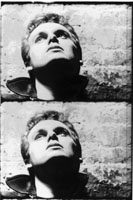
"An artist is somebody who produces things that people don't need to have," Andy Warhol once noted. But after viewing the superb new presentation of Andy's early films at MoMA, you might reword that to: "Art is something people don't need to have but are better off having."
Sublimely organized by Klaus Biesenbach, MoMA's acclaimed Chief Curator at Large, the films, each situated in a black frame, some measuring seven feet high and nine feet wide, are almost reminiscent of the paintings hanging at Hogwarts School of Witchcraft and Wizardry, except these won't scream at you, which is a bit of a shame. Who wouldn't like to be vocally abused by Nico or Dennis Hopper?
The majority of the offerings, part of a group labeled "Screen Tests," are four minutes in length and on a constant loop. So if you elevator up to MoMA's sixth floor, you can watch the hunky blond Paul America chew gum for eternity; gaze everlastingly at the flawlessly beautiful Gino Piserchio, who seems to enjoy bathing his loveliness before the camera's eye and yours; plus ogle Baby Jane Holzer, who brushes her teeth perpetually with a vigor that would arouse anyone in the dental profession. Nearby the late Japanese actress Kyoko Kishida will smile at you with a becoming modesty, Edie Sedgwick will just stare and stare, while Donyale Luna, the first African-American model to appear on the cover of British Vogue (1966), will hardly be contained in her frame. Flashing her two-inch-long nails while flirting and fiddling with her hair, she's pure energy, unlike her peers in the room, Susan Sontag and Lou Reed, who are much self-contained.
There are lengthier works on show, too. Warhol's 54-minute Kiss (1963-1964), has a wide variety of couples smooching with an enviable stamina for three minutes each. That's when the film magazine that Warhol used ran out. Steven Watson critiques in his Factory Made: Warhol and the Sixties that watching the puckering pairs "as a series had the effect of coitus interruptus -- Kiss never rose to a climax -- the repetition leveled the erotic charge, as if the kisses were products off an assembly line." I beg to differ. Each osculation, at least for the twenty minutes I watched, seemed quite individualistic. For example, during the interracial canoodling, the female seems quite happy, and it appears if a tongue weren't being thrust down her throat, she'd be laughing aloud. Some other participants are much more serious. Which reminds me that Ingmar Bergman one time insisted "a kiss is a lovely trick designed by nature to stop speech when words become superfluous." Being aware of Warhol's low opinion of his coterie, he might just have made this opus to shut his pals up.
As for the infamous Blow Job (1963), it gets a wall unto itself. This 41-minute ode to receiving oral sex has the camera trained on the face of an unknown leather-jacketed porn actor of the time as he leans against a wall while someone we never see services him. Apparently, when the film was screened for a bunch of Columbia University students, they started singing, "We Shall Never Come!"
These engaging tidbits of celluloid no doubt helped Warhol hone his sense of the film medium, which he, with Paul Morrisey, later put to good use, turning out such "classics" as Trash, Heat, Frankenstein, and Bad. In the end, I'm not sure how whether this exhibition will have the same power for those who didn't live through the Warhol era, those folks who do not realize how revolutionary in style and content Warhol's work was -- while also satirical and self-promoting. For me, the exhibit is like being surrounded by old friends. I hope for others it will be an incentive to make new ones.
(The exhibit runs from Dec. 19, 2010 to March 21, 2011.)
